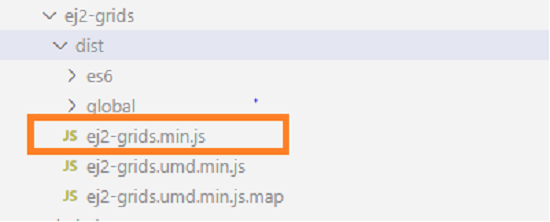Getting Started with Syncfusion® React Components using Webpack Externals
20 Aug 202510 minutes to read
This article provides a step-by-step guide for configuring a React application to use Syncfusion® React components with Webpack Externals. Webpack Externals instruct Webpack to treat specified dependencies as external, loading them via CDN or global variables instead of bundling them into your app.
This approach helps reduce bundle sizes and allows for sharing libraries via CDN script references.
Prerequisites
System requirements for Syncfusion® React UI components
Create a React application
-
Open a terminal and create a new application folder:
mkdir Syncfusion-react-demo cd Syncfusion-react-demo -
Use the following commands to create a
package.jsonfile. Then install the react and react-dom packages in the application.npm init npm install react react-dom
Add Syncfusion® React packages
Install the required Syncfusion® React component package in the application. All Syncfusion® React (Essential® JS 2) packages are published on the npmjs.com public registry. So, choose the component that you want to install.
In this article, the Grid component is used as an example. To install the Grid component package, use the following command.
npm install @syncfusion/ej2-react-grids --saveAdd babel packages
Install the required babel presets packages in the application.
npm install babel-loader @babel/preset-react @babel/preset-env @babel/core --save-devAdd Syncfusion® Grid component
-
Create an
srcfolder in the application repository. Then create anindex.html,index.jsentry andApp.jscomponent files inside thesrcfolder location. Start adding the required components to the application. -
Open the
src/App.jsfile and add the Grid component as follows.import React from "react"; import { ColumnDirective, ColumnsDirective, GridComponent } from '@syncfusion/ej2-react-grids'; function App() { const data = [ { OrderID: 10248, CustomerID: 'VINET', EmployeeID: 5, OrderDate: new Date(8364186e5), ShipName: 'Vins et alcools Chevalier', ShipCity: 'Reims', ShipAddress: '59 rue de l Abbaye', ShipRegion: 'CJ', ShipPostalCode: '51100', ShipCountry: 'France', Freight: 32.38, Verified: !0 }, { OrderID: 10249, CustomerID: 'TOMSP', EmployeeID: 6, OrderDate: new Date(836505e6), ShipName: 'Toms Spezialitäten', ShipCity: 'Münster', ShipAddress: 'Luisenstr. 48', ShipRegion: 'CJ', ShipPostalCode: '44087', ShipCountry: 'Germany', Freight: 11.61, Verified: !1 }, { OrderID: 10250, CustomerID: 'HANAR', EmployeeID: 4, OrderDate: new Date(8367642e5), ShipName: 'Hanari Carnes', ShipCity: 'Rio de Janeiro', ShipAddress: 'Rua do Paço, 67', ShipRegion: 'RJ', ShipPostalCode: '05454-876', ShipCountry: 'Brazil', Freight: 65.83, Verified: !0 } ]; return ( <GridComponent dataSource={data}> <ColumnsDirective> <ColumnDirective field='OrderID' width='100' textAlign="Right"/> <ColumnDirective field='CustomerID' width='100'/> <ColumnDirective field='EmployeeID' width='100' textAlign="Right"/> <ColumnDirective field='Freight' width='100' format="C2" textAlign="Right"/> <ColumnDirective field='ShipCountry' width='100'/> </ColumnsDirective> </GridComponent> ); } export default App; -
Open the
src/index.jsfile and add the app component as follows.
import React from "react";
import ReactDOM from "react-dom/client";
import App from "./App";
const root = ReactDOM.createRoot(document.getElementById("root"));
root.render(
<App />
);Install and configure the webpack
-
Install the webpack packages by using the following command.
npm install webpack webpack-cli webpack-dev-server html-webpack-plugin --save-dev -
Create a
webpack.config.jsfile in the application root repository using the following code sample.
const path = require('path');
const HTMLWebpackPlugin = require('html-webpack-plugin');
module.exports = {
entry: path.resolve(__dirname, "src/index.js"),
output: {
path: path.join(__dirname, '/build'),
filename: 'bundles.js',
libraryTarget: 'umd',
},
plugins: [
new HTMLWebpackPlugin({
template: './src/index.html'
}),
],
module: {
rules: [
{
test: /\.js$/,
exclude: /node_modules/,
use: {
loader: "babel-loader",
options: {
presets: ["@babel/preset-env", "@babel/preset-react"]
}
}
},
]
}
}Configure Webpack externals
-
The Syncfusion® React externals naming convention is
SyncfusionReact[PackageName], wherePackageNameis PascalCase (e.g.,SyncfusionReactGrids). -
Open the
webpack.config.jsfile and add the Syncfusion® react packages in the externals option as follows.module.exports = { --- externals: { "react": "React", "react-dom": "ReactDOM", "@syncfusion/ej2-react-grids": "SyncfusionReactGrids" }, --- } -
Find the Syncfusion® external CDN script
[package-name].min.jsfile insidedistfolder of the packages.
-
Add the React and Syncfusion® react Grid CDN references in the
src/index.htmlfile. The order of individual Syncfusion® control package loading should be in line with its dependency graph. The CDN of the Dependency Packages should be included manually before the intended individual Syncfusion® control package CDN.
<!DOCTYPE html>
<html lang="en">
<head>
<meta charset="UTF-8">
<meta http-equiv="X-UA-Compatible" content="IE=edge">
<meta name="viewport" content="width=device-width, initial-scale=1.0">
<!-- React and ReactDom scripts -->
<script crossorigin src="https://unpkg.com/[email protected]/umd/react.production.min.js"></script>
<script crossorigin src="https://unpkg.com/[email protected]/umd/react-dom.production.min.js"></script>
<!-- Syncfusion React controls styles -->
<link rel="stylesheet" href="https://cdn.syncfusion.com/ej2/27.2.2/material.css" />
<!-- Syncfusion React controls scripts -->
<script src="https://cdn.syncfusion.com/ej2/27.2.2/ej2-base/dist/ej2-base.min.js"></script>
<script src="https://cdn.syncfusion.com/ej2/27.2.2/ej2-data/dist/ej2-data.min.js"></script>
<script src="https://cdn.syncfusion.com/ej2/27.2.2/ej2-buttons/dist/ej2-buttons.min.js"></script>
<script src="https://cdn.syncfusion.com/ej2/27.2.2/ej2-splitbuttons/dist/ej2-splitbuttons.min.js"></script>
<script src="https://cdn.syncfusion.com/ej2/27.2.2/ej2-popups/dist/ej2-popups.min.js"></script>
<script src="https://cdn.syncfusion.com/ej2/27.2.2/ej2-navigations/dist/ej2-navigations.min.js"></script>
<script src="https://cdn.syncfusion.com/ej2/27.2.2/ej2-inputs/dist/ej2-inputs.min.js"></script>
<script src="https://cdn.syncfusion.com/ej2/27.2.2/ej2-dropdowns/dist/ej2-dropdowns.min.js"></script>
<script src="https://cdn.syncfusion.com/ej2/27.2.2/ej2-calendars/dist/ej2-calendars.min.js"></script>
<script src="https://cdn.syncfusion.com/ej2/27.2.2/ej2-lists/dist/ej2-lists.min.js"></script>
<script src="https://cdn.syncfusion.com/ej2/27.2.2/ej2-excel-export/dist/ej2-excel-export.min.js"></script>
<script src="https://cdn.syncfusion.com/ej2/27.2.2/ej2-pdf-export/dist/ej2-pdf-export.min.js"></script>
<script src="https://cdn.syncfusion.com/ej2/27.2.2/ej2-file-utils/dist/ej2-file-utils.min.js"></script>
<script src="https://cdn.syncfusion.com/ej2/27.2.2/ej2-compression/dist/ej2-compression.min.js"></script>
<script src="https://cdn.syncfusion.com/ej2/27.2.2/ej2-grids/dist/ej2-grids.min.js"></script>
<script src="https://cdn.syncfusion.com/ej2/27.2.2/ej2-react-base/dist/ej2-react-base.min.js"></script>
<script src="https://cdn.syncfusion.com/ej2/27.2.2/ej2-react-grids/dist/ej2-react-grids.min.js"></script>
<title>Document</title>
</head>
<body>
<div id="root"></div>
</body>
</html>Refer to the Script Dependency section to discover the correct script reference sequence and its dependencies for a certain Syncfusion® React component.
Configure the package JSON
Open the package.json file and configure the application process in the scripts as follows.
{
"scripts": {
"start": "webpack-dev-server --mode development --open --hot",
"build": "webpack --mode production"
}
}
Run the application
Run the application using the following command.
npm startThe application displays a Syncfusion Grid component as shown below:
